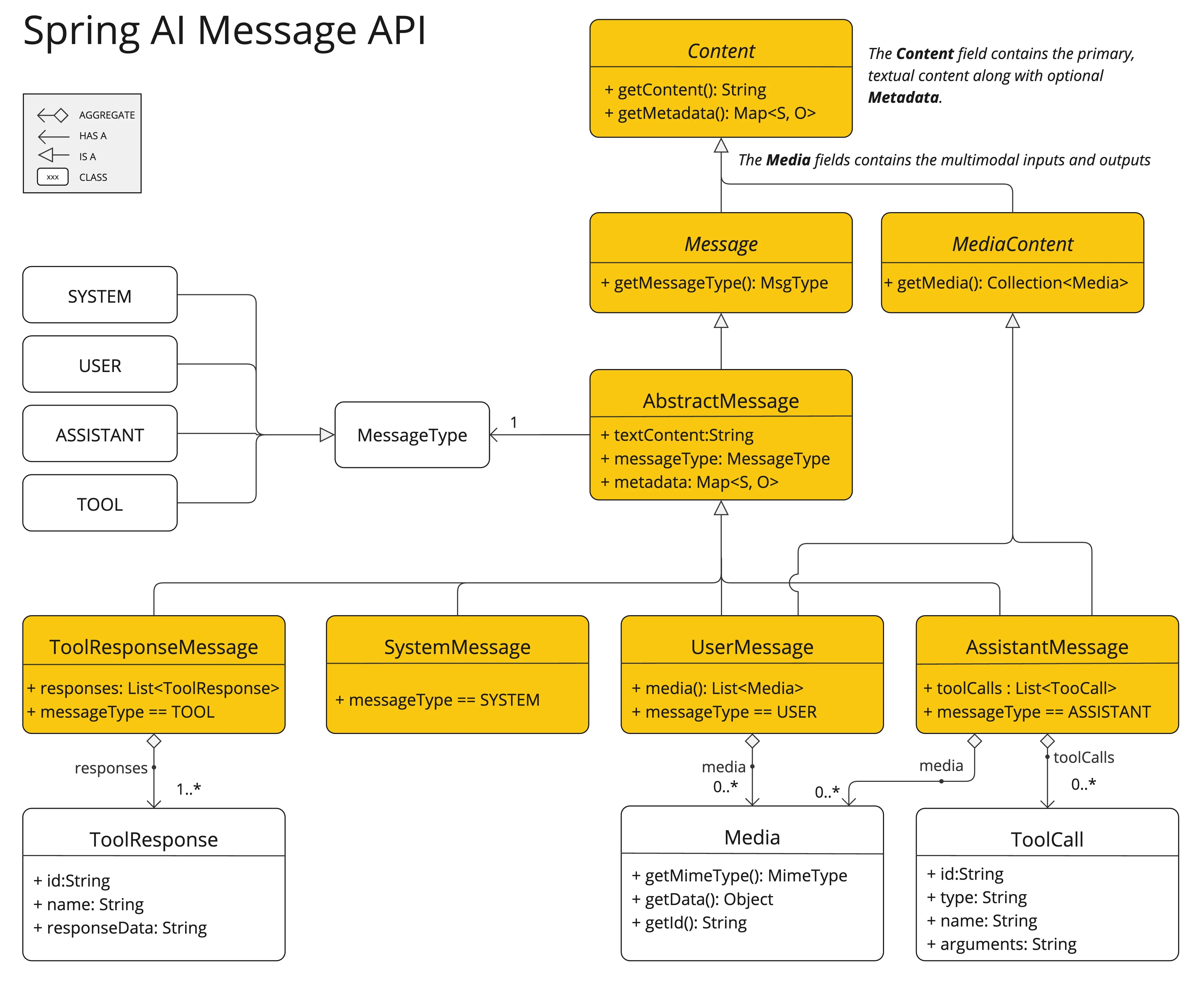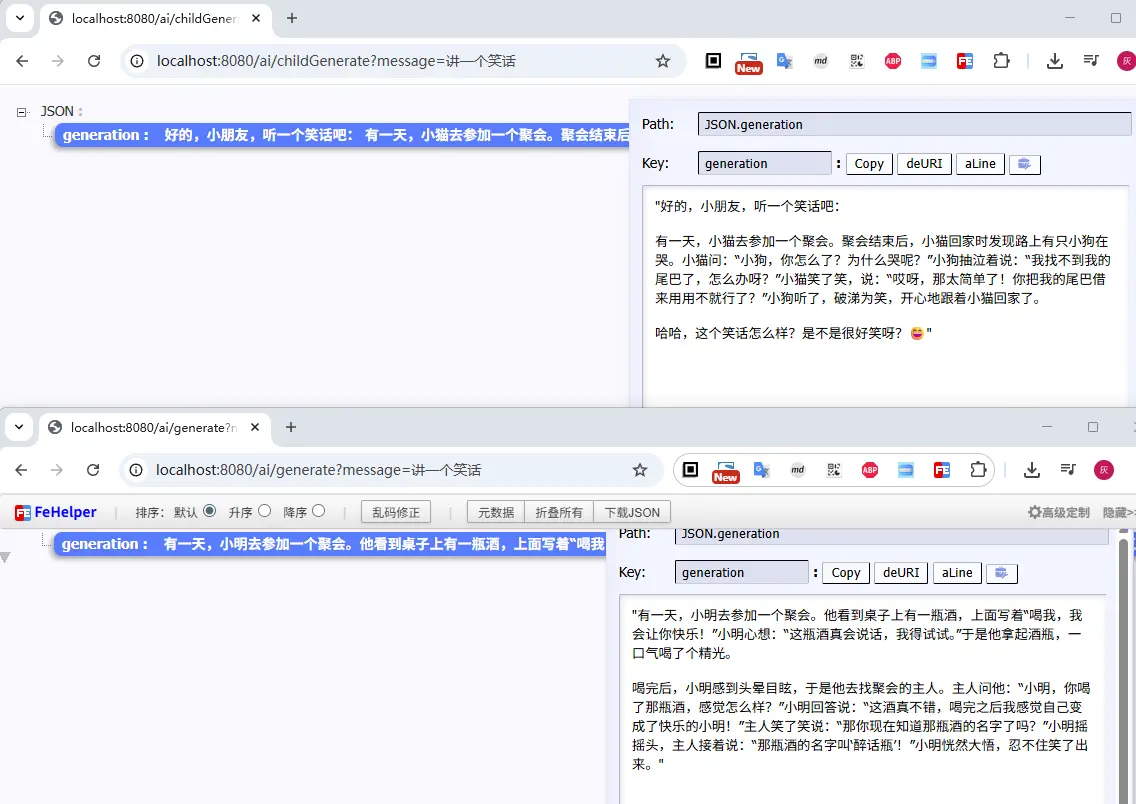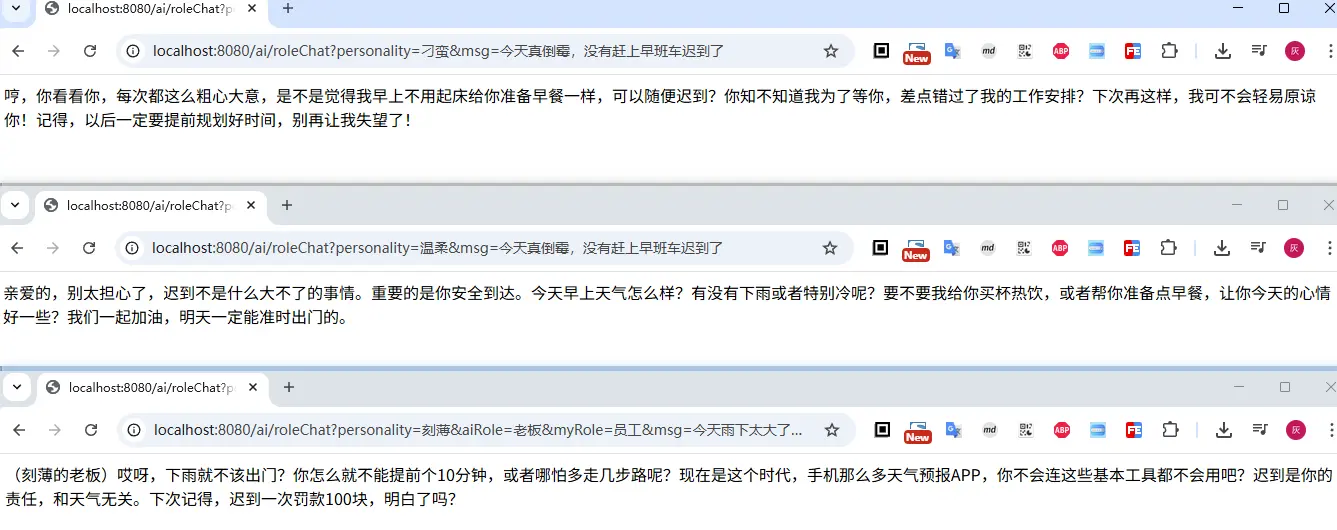02.提示词的使用
02. 提示词的使用
上一篇文章快速带大家基于SpringAi创建了一个调用大模型的示例工程,接下来我们将进入一些大模型交互的细节,这里主要介绍如何使用提示词,以使大模型的输出更加符合我们的需求
一、基础知识
1. 提示词(Prompt)
提示词:Prompt,也可以理解为预设,是模型在开始对话时,预先设定的一些内容,这些内容会作为模型输入,从而影响模型输出的结果。
SpringAI中,我们使用 Prompt 类来表示一个提示词,Prompt 类中包含一个 List<Message> 属性,用于表示提示词中的消息列表。
public class Prompt implements ModelRequest<List<Message>> {
// 消息列表
private final List<Message> messages;
private ChatOptions chatOptions;
}
2. 消息(Message)
用户与大模型中间的对话,通常是由一个或多个消息组成,其中每个消息都需要与一个角色关联;角色表示消息作者的角色。
SpringAI中,我们使用 Message 类来表示一个消息,Message 类中包含一个 MessageType 属性,用于表示消息的类型。
public interface Content {
String getContent();
Map<String, Object> getMetadata();
}
public interface Message extends Content {
MessageType getMessageType();
}
上面定义的MessageType定义消息类型,和大模型中定义的角色进行映射,ChatGPT了解它应该如何行为以及谁在发起调用

通常有四种角色:
- system: 系统角色,用于通过分配特定行为给大模型来创建对话的上下文或范围,通常我们预设的提示词会和
system角色关联 - user: 用户角色,用于表示用户输入的文本,通常我们输入的提问也会和
user角色关联 - assistant: 助手角色,用于表示模型生成的文本,通常大模型生成的答案也会和
assistant角色关联 - tool: 工具角色,用于表示模型调用的函数返回的内容,会和
tool角色关联
3. 提示词模板
提示词实际上是一个字符串,若提示词全部由程序预设,会导致提示词的复用性差,因此,SpringAI提供了一种模板语法,用于生成提示词,模板语法如下:
You are a helpful AI assistant that helps people find information.
Your name is {name}
You should reply to the user's request with your name and also in the style of a {voice}.
模板语法中,{name} 和 {voice} 是模板变量,模板变量的值会根据调用时传入的参数进行替换
关联的类定义如下
// 提示词模板
public class PromptTemplate implements PromptTemplateActions, PromptTemplateMessageActions {
}
// 提示词模板解析渲染,即使用传入的Map替换模板中的变量
public interface TemplateRenderer extends BiFunction<String, Map<String, Object>, String> {
@Override
String apply(String template, Map<String, Object> variables);
}
二、实例演示
首先我们需要创建一个SpringAI的项目,基本流程同 创建一个SpringAI-Demo工程
1. 提示词基础使用
我们这里同样基于智普的免费大模型进行演示,首先创建一个Controller控制器
@RestController
public class ChatController {
private final ZhiPuAiChatModel chatModel;
@Autowired
public ChatController(ZhiPuAiChatModel chatModel) {
this.chatModel = chatModel;
}
}
然后再定义一个对话的接口,还是与之前的demo工程的一样,接收用户的传入文本,不同的地方在于我们再方式实现中,显示创建一个提示词
@GetMapping("/ai/generate")
public Map generate(@RequestParam(value = "message", defaultValue = "Tell me a joke") String message) {
Prompt prompt = new Prompt(message,
ZhiPuAiChatOptions.builder()
.model(ZhiPuAiApi.ChatModel.GLM_4_Flash.getValue())
.temperature(0.7d)
.user("一灰灰")
.build()
);
Generation generation = chatModel.call(prompt).getResult();
return Map.of("generation", generation == null ? "" : generation.getOutput().getText());
}
提示词的创建方式比较简单,直接new一个对象,如上面的示例
- 第一个参数:string类型:默认表示用户输入的消息
- 第二个参数:ChatOptions类型:表示模型调用的参数,如模型名称、温度、用户名称等
temperature参数作用:- 用于控制生成文本的随机性或创造性。
- 数值范围一般在
0.0到1.0之间(有时也可超出该范围):- 当
temperature接近0.0时,输出会趋于确定性和保守,通常选择概率最高的词; - 当
temperature接近1.0或更高时,输出更具多样性和创造性,可能会选择低概率但更有趣的词。
- 当
- 示例中设置为
0.7d,表示适度平衡确定性与多样性。
user参数作用:- 用于标识请求的发起者,通常是用户的唯一标识符(如用户名、ID 等)。
- 主要用途包括:
- 日志记录和审计:便于追踪哪个用户触发了此次 AI 调用;
- 配额管理:某些平台依据
user字段进行使用量统计与限制; - 行为分析:用于后续的数据分析或个性化推荐等场景。
- 示例中设置为
"一灰灰",可能代表当前请求来源的用户身份标识。
如果我们希望预设一个系统的提示词,比如给大模型定义一个身份:“你现在是一个专注于给3-5岁儿童聊天的助手”,那么我们可以这样创建一个提示词:
@GetMapping("/ai/childGenerate")
public Map childJokeGenerate(@RequestParam(value = "message", defaultValue = "Tell me a joke") String message) {
Prompt prompt = new Prompt(
Arrays.asList(new SystemMessage("你现在是一个专注于给3-5岁儿童聊天的助手"), new UserMessage(message)),
ZhiPuAiChatOptions.builder()
.model(ZhiPuAiApi.ChatModel.GLM_4_Flash.getValue())
.temperature(0.7d)
.user("一灰灰")
.build()
);
Generation generation = chatModel.call(prompt).getResult();
return Map.of("generation", generation == null ? "" : generation.getOutput().getText());
}
接下来我们访问对比一下上面两个接口的返回情况,很明显childGenerate生成的笑话内容更适合3-5岁小朋友

小结一下,提示词的使用方式:
// 直接创建一个用户的消息提示词
Prompt prompt = new Prompt(text);
// 若我们需要创建不同角色的消息,则可以使用
Prompt prompt = new Prompt(new SystemMessage("xxx"), new UserMessage("xxx"));
// 若希望指定模型调用的参数,则需要使用 ChatOptions
Prompt prompt = new Prompt(text, ZhiPuAiChatOptions.builder().temperature(0.7d).build());
2. 提示词模板
接下来我们再来看一下提示词模板的使用示例,创建一个角色扮演的接口,我们预设的系统提示词模板为
我们现在开始角色扮演的聊天,你来扮演{personality}的{aiRole}, 我来扮演{myRole}
直接借助SpringAI提供的 PromptTemplate 来实现提示词模板的解析,常见的使用方式
// 这里创建的是 UserMessage 类型的提示词
PromptTemplate promptTemplate = new PromptTemplate("Tell me a {adjective} joke about {topic}");
Prompt prompt = promptTemplate.create(Map.of("adjective", adjective, "topic", topic));
接下来我们创建一个接口,接收三个参数,分别表示角色的个性、角色名称、用户角色名称,然后使用模板渲染,并创建一个系统提示词,实现与用户的对话
@GetMapping(path = "/ai/roleChat")
public String roleChat(@RequestParam(value = "personality", defaultValue = "温柔") String personality,
@RequestParam(value = "aiRole", defaultValue = "女朋友") String aiRole,
@RequestParam(value = "myRole", defaultValue = "男朋友") String myRole,
@RequestParam(value = "msg", defaultValue = "最近心情不好") String msg) {
PromptTemplate promptTemplate = new PromptTemplate("我们现在开始角色扮演的聊天,你来扮演{personality}的{aiRole}, 我来扮演{myRole}");
String text = promptTemplate.render(Map.of("personality", personality, "aiRole", aiRole, "myRole", myRole));
Prompt prompt = new Prompt(new SystemMessage(text), new UserMessage(msg));
Generation generation = chatModel.call(prompt).getResult();
return generation == null ? "" : generation.getOutput().getText();
}
接下来我们看看传入不同的参数的表现情况
http://localhost:8080/ai/roleChat?personality=刁蛮&msg=今天真倒霉,没有赶上早班车迟到了
http://localhost:8080/ai/roleChat?personality=温柔&msg=今天真倒霉,没有赶上早班车迟到了
http://localhost:8080/ai/roleChat?personality=刻薄&aiRole=老板&myRole=员工&msg=今天雨下太大了,没有赶上早班车迟到了

从上面的输出也可以看出,当我传入不同的角色描述,返回的对话信息也会根据我的描述进行显著的变化
3. 提示词高级使用
通过提示词模板promptTemplate.create创建的提示词,默认是创建UserMessage类型的消息;如果我们希望创建的是系统提示词呢?可以使用SystemPromptTemplate
@GetMapping(path = "/ai/roleChat")
public String roleChat(@RequestParam(value = "personality", defaultValue = "温柔") String personality,
@RequestParam(value = "aiRole", defaultValue = "女朋友") String aiRole,
@RequestParam(value = "myRole", defaultValue = "男朋友") String myRole,
@RequestParam(value = "msg", defaultValue = "最近心情不好") String msg) {
SystemPromptTemplate promptTemplate = new SystemPromptTemplate("我们现在开始角色扮演的聊天,你来扮演{personality}的{aiRole}, 我来扮演{myRole}");
Message systemMsg = promptTemplate.createMessage(Map.of("personality", personality, "aiRole", aiRole, "myRole", myRole));
Prompt prompt = new Prompt(systemMsg, new UserMessage(msg));
Generation generation = chatModel.call(prompt).getResult();
return generation == null ? "" : generation.getOutput().getText();
}
默认情况下,提示词模板中需要替换的内容是放在{}中的,当然我们也可以自定义替换的内容,比如使用<>来替换,此时我们需要在创建PromptTemplate的时候传入一个参数delimiter,表示替换内容的分隔符
PromptTemplate promptTemplate = PromptTemplate.builder().renderer(StTemplateRenderer.builder()
.startDelimiterToken('<').endDelimiterToken('>').build())
.template("我们现在开始角色扮演的对话,你来扮演{personality}的{aiRole}, 我来扮演{myRole}")
.build();
String text = promptTemplate.render(Map.of("personality", personality, "aiRole", aiRole, "myRole", myRole));
提示词的使用,除了上面的字符串硬编码方式之外,SpringAI还提供了资源注入的方式,如
@Value("classpath:/prompts/system-message.st")
private Resource systemResource;
SystemPromptTemplate systemPromptTemplate = new SystemPromptTemplate(systemResource);
三、小结
本文主要介绍在SpringAI中提示词的使用方式,如最基本的大模型交互时,由SpringAI默认根据文本封装一个用户消息
// 接收一个文本,封装成用户消息,返回大模型的响应文本
chatModel.call(message);
当然也可以手动创建
Prompt prompt = new Prompt(new UserMessage(message));
chatModel.call(prompt);
如提示词有复用的场景,则优先考虑提示词模板
PromptTemplate promptTemplate = new PromptTemplate("Tell me a {adjective} joke about {topic}");
Prompt prompt = promptTemplate.create(Map.of("adjective", adjective, "topic", topic));
chatModel.call(prompt);
文中所有涉及到的代码,可以到项目中获取 https://github.com/liuyueyi/spring-ai-demo